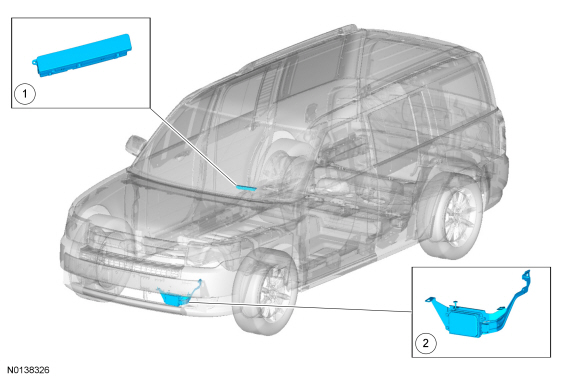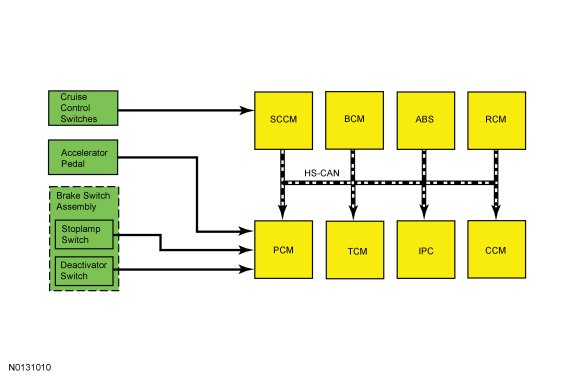SECTION 419-03B: Cruise Control — Adaptive
| 2014 Flex Workshop Manual
|
DESCRIPTION AND OPERATION
| Procedure revision date: 05/02/2013
|
Component Location

| Item | Description | Comments |
|---|---|---|
| 1 | HUD module | - |
| 2 | C-CM | - |
Overview
The adaptive cruise control system is controlled by the steering wheel mounted switches (ON/OFF, SET, CNCL, RES and GAP) that are integrated into the LH steering wheel switch.
The cruise control system maintains a selected vehicle speed between 29 kmh (18 mph) and the maximum limited vehicle speed and displays that speed in the IPC message center. When a MyKey® restricted key is in use and maximum speed limiter is turned on, vehicle speed is limited. The maximum vehicle speed can be set to 105 kmh (65 mph), 113 kmh (70 mph), 121 kmh (75 mph), or 129 kmh (80 mph).
The vehicle maintains the selected speed until another slower vehicle is detected ahead in the same lane by the radar sensor unit inside the C-CM . The vehicle speed is adjusted automatically to maintain a preset distance gap. The vehicle maintains the distance gap and the brakes automatically apply to slow the vehicle to maintain the gap to the vehicle ahead.
The cruise control system is controlled by the PCM.
System Operation

Network Message Chart
Module Network Input Messages — ABS Module
| Broadcast Message | Originating Module | Message Purpose |
|---|---|---|
| Adaptive cruise control brake deceleration request | C-CM | Used for cruise control automatic braking. |
| Brake pedal applied | PCM | Used for brake switch input. |
Module Network Input Messages — C-CM
| Broadcast Message | Originating Module | Message Purpose |
|---|---|---|
| Accelerator pedal position | PCM | Used for accelerator pedal status. |
| Vehicle configuration data | BCM | Used for comparison checking adaptive cruise control configuration. |
| Brake pedal applied | PCM | Used for brake switch input. |
| Cruise control override | PCM | Deactivates cruise control. |
| Ignition status | BCM | Used for ignition switch position input. |
| Steering wheel switch speed control | SCCM | Used for cruise control enable/disable, gap settings and operating mode request. |
| Stability control event in progress | ABS module | Deactivates cruise control when requested. |
| Traction control event in progress | ||
| Vehicle lateral acceleration | RCM | Deactivates cruise control when requested. |
| Vehicle longitudinal acceleration | ||
| Vehicle yaw rate |
Module Network Input Messages — IPC
| Broadcast Message | Originating Module | Message Purpose |
|---|---|---|
| Adaptive cruise control gap setting | C-CM | Data used to generate message center display indicating adaptive cruise control gap setting. |
| Adaptive cruise control message display | C-CM | Data used to generate message center display indicating adaptive cruise control status. |
| Cruise control mode | PCM | Toggles between cruise control and adaptive cruise control. |
| Cruise control override | PCM | Driver overriding cruise control with accelerator pedal. |
| Cruise control status | PCM | Data used for cruise control indicator status. |
Module Network Input Messages — PCM
| Broadcast Message | Originating Module | Message Purpose |
|---|---|---|
| Steering wheel switch speed control | SCCM | Used for cruise control enable/disable and operating mode request. |
| Speed control deactivation request | ABS module | Deactivates cruise control when requested. |
| Stability control event in progress | ||
| Traction control event in progress | ||
| Vehicle lateral acceleration | RCM | Deactivates cruise control when requested. |
| Vehicle longitudinal acceleration | ||
| Vehicle roll sense | ||
| Vehicle yaw rate |
Adaptive Cruise Control (ACC) Operation
NOTE: For a complete illustration of the adaptive cruise control indicators and graphic displays, refer to the Owner's Literature.
The adaptive cruise control system functions much like the standard cruise control system. The adaptive cruise control system automatically adjusts the vehicle speed to maintain a set gap distance from the front of the vehicle and the vehicle in the same path of travel. When the adaptive cruise control system is on and is following a vehicle ahead or a vehicle enters the same driving lane, a follow vehicle graphic is displayed in the message center.
The adaptive cruise control system does not function if the vehicle speed is below 29 kmh (18 mph). As the vehicle slows down during automatic braking, the adaptive cruise control system discontinues braking at 29 kmh (18 mph). At that speed, an audible alarm sounds and the automatic braking from the ABS module is released. The driver must take over the vehicle braking control.
The cruise control deactivator switch (which is integral to the stoplamp switch) is an additional safety feature. When the brake pedal is pressed, an electrical signal is sent from the stoplamp switch to the PCM deactivating the cruise control system. Under increased brake pedal effort, the cruise control deactivator switch opens and removes the ground signal from the PCM input circuit releasing the throttle, immediately deactivating the system.
The ABS module monitors the yaw rate signal from the RCM and compares it to the wheel speed and steering wheel angle signals. If the ABS module determines the yaw rate is invalid, the ABS module disables the adaptive cruise control. The message center displays the message COLLISION WARNING MALFUNCTION and/or ADAPTIVE CRUISE MALFUNCTION.
The ABS module estimates brake temperature by monitoring applied brake pressure over a period of time and sends a message to the C-CM when the estimated temperature is above a given threshold. An alarm sounds and the adaptive cruise control system is deactivated until the estimated brake temperature within the ABS module returns to cooler operating conditions. This condition can happen in a hilly or mountainous driving terrain.
Cruise Control Indicator
The adaptive cruise control indicator located in the IPC illuminates gray and the previous gap setting and SET graphic is displayed indicating the system is in standby mode. This notifies the driver that the system is ready and the vehicle can be accelerated to the desired speed.
Steering Wheel Switch Function
The adaptive cruise control steering wheel mounted switches are momentary contact switches that toggle up and down for the cruise control switch state. Pressing and releasing the steering wheel cruise control ON/OFF switch turns the cruise control system on. Pressing up (SET+) and releasing the SET switch sets the vehicle's speed and stores the set speed in memory. The adaptive cruise control indicator illuminates green and the message center displays the set speed and gap setting graphic.
There are 2 ways to change the set speed. The first way is to accelerate or brake to the desired speed and press and release the SET cruise control switch until the desired set speed is shown on the message center. The second way is by tapping the SET+ or the SET- switch while in the set mode, increasing or decreasing the displayed set speed by 1.6 kmh (1 mph) per tap. If the respective button is pressed and held, the displayed set speed continues to increase or decrease until the button is released. The adaptive cruise control system may apply the brakes to slow the vehicle down to the new set speed. The set speed displays continuously in the message center while the adaptive cruise control system is active.
Pressing and releasing the OFF switch, or switching the ignition to OFF, turns the adaptive cruise control system off. The adaptive cruise control set speed memory is erased.
Pressing the brake pedal or pressing the RES/CNCL switch puts the adaptive cruise control system in standby mode and the last set speed is displayed in the message center with a strike through. Pressing the RES/CNCL button when the adaptive cruise control system is in standby mode causes the vehicle to accelerate to the last set speed. The set speed continuously displays in the message center while the adaptive cruise control system is active. The RES/CNCL button does not function if the OFF button is pressed, the ignition is cycled OFF, or if the current vehicle speed is below the minimum operational speed.
The adaptive cruise control system has the capability for the driver to change from adaptive cruise control to standard cruise control. The LH 5-way steering wheel switch is used to switch from the adaptive cruise control system to standard cruise control system within the message center. For information on selecting the standard cruise control in the message center, refer to Owner's Literature. Once the driver has selected the standard cruise control in the message center, the adaptive cruise control indicator is replaced by the standard cruise control indicator. The vehicle no longer responds to lead vehicles or automatic braking. Upon the next vehicle ignition cycle, the vehicle defaults back to the adaptive cruise control system.
Gap Setting
When a vehicle ahead enters the same lane or a slower vehicle is ahead in the same lane, the vehicle speed adjusts automatically to maintain a preset distance gap. A bar graph graphic with 4 preset distance gap settings are displayed in the message center. Pressing up (decrease) or down (increase) on the steering wheel cruise control gap switch increases or decreases the distance from the vehicle ahead. If all of the bars are illuminated, this is the longest gap setting. If only one bar is illuminated that is the shortest gap setting.
The vehicle maintains the distance gap to the vehicle ahead until:
After each ignition cycle, the previous gap setting is remembered and the system is set to that gap setting.
The distance gap can be overridden by pressing the accelerator pedal. The follow vehicle graphic is not displayed in the message center and the GAP and set speed display turns gray. When the accelerator is released, the adaptive cruise control system returns to normal operation and the vehicle speed decreases to the set speed or a lower speed if following a vehicle ahead.
Deceleration Control
The C-CM commands the ABS module, which controls the brakes, to automatically apply the brakes to slow the vehicle to maintain a safe distance to the vehicle in front.
Cruise Control Deactivation Event Parameter Identification (PIDs)
NOTE: When recording deactivation event PIDs, turn the cruise control OFF immediately after the deactivation event occurs to prevent recording additional deactivation events which do not apply to the fault present.
The PCM has PIDs available, through the powertrain DataLogger, that indicate the event that caused the last cruise control deactivation. When the cruise control is turned ON, all current deactivation (or non-activation) conditions are recorded. When the cruise control is turned OFF, event recording stops. The recorded events are stored until the ignition is turned OFF.
The PCM has 24 cruise control deactivation event PIDs, identified as CRUISEOFF_00 through 24. The event PIDs should be read when deactivation or non-activation exists.
Component Description
Steering Wheel Switches
The cruise control steering wheel mounted switches are momentary contact switches that toggle up and down for the switch state. The switches are an input to the SCCM .
Brake Switch
When the brake pedal is applied, an electrical signal from the stoplamp circuit to the PCM deactivates the system. Under increased brake pedal effort, the cruise control deactivator switch opens and removes the ground signal from the PCM input circuit releasing the throttle, immediately deactivating the system.
C-CM
The C-CM contains the radar sensing unit which measures the distance between the front of the vehicle and the vehicle being followed. The C-CM is responsible for requesting the PCM increase vehicle speed and for requesting the ABS to brake when necessary.